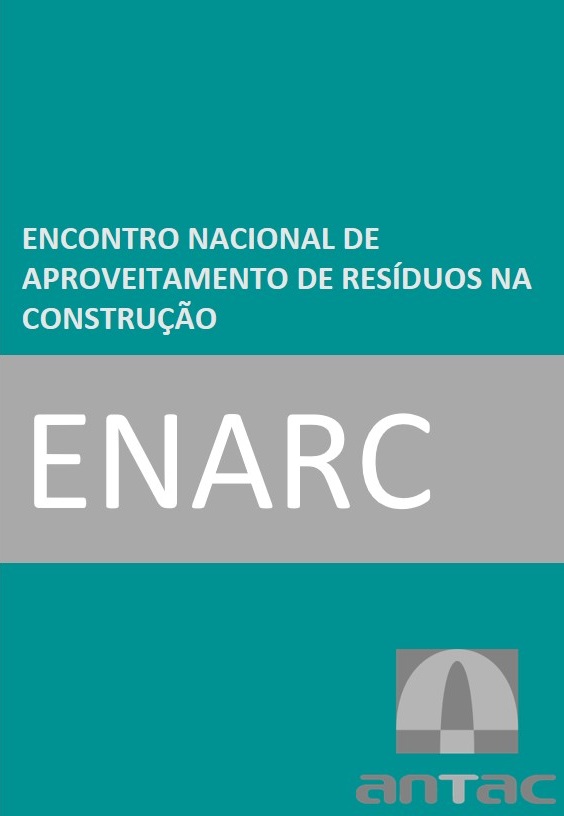Pervious concretes with recycled aggregate: evaluation of CO2 diffusibility
DOI:
https://doi.org/10.46421/enarc.v8i00.3005Keywords:
Construction and Demolition Waste (CDW), Permeable Pavement, Carbon Capture, Use and Storage (CCUS)Abstract
This study aims to analyze the diffusibility of CO2 in pervious concrete considering varying proportions of mixed recycled aggregate (AR). Pervious concrete mixes, containing 15%, 30%, and 45% AR, were subjected to initial assessments of their hydraulic and mechanical properties. Subsequently, they were exposed to accelerated carbonation over a span of 48 hours within a controlled environment featuring 5% CO2, 60% humidity, and a temperature of 23 ± 5 °C. The analysis of CO2 diffusion was conducted using the phenolphthalein chemical indicator and ImageJ software. The findings demonstrate that pervious concrete incorporating recycled aggregate satisfies the hydraulic prerequisites outlined in Brazilian regulations (NBR 16416:2015) and exhibits a capacity for CO2 sequestration, with effectiveness correlated to the increased incorporation of recycled aggregate.
References
ASSOCIAÇÃO BRASILEIRA DE NORMAS TÉCNICAS- ABNT. NBR 7222: Argamassa e concreto - Determinação da resistência à tração por compressão diametral de corpos-de-prova cilíndricos. Rio de Janeiro, 2011.
________. NBR 5738: Concreto - Procedimento para moldagem e cura de corpos de prova. Rio de Janeiro, 2015a.
________.NBR 16416: Pavimentos permeáveis de concreto - Requisitos e procedimentos. Rio de Janeiro, 2015b.
________. NBR 5739: Concreto — Ensaio de compressão de corpos de prova cilíndricos. Rio de Janeiro, 2018.
______.NBR 16889: Concreto — Determinação da consistência pelo abatimento do tronco de cone. Rio de Janeiro, 2020.
ACI 522-R10. Report On Pervious Concrete (ACI 522-R10).
ANGULO, S. C.; OLIVEIRA, L. S.; MACHADO, L. Pesquisa setorial ABRECON 2020: a reciclagem de resíduos de construção e demolição no Brasil. ABRECON, 2022.
ANGULO, S. C.; MUELLER, A. Determination of construction and demolition recycled aggregates composition, in considering their heterogeneity. Materials and Structures/Materiaux et Constructions, v. 42, n. 6, p. 739–748, 2009.
BATEZINI, R. Estudo preliminar de concretos permeáveis como revestimentos de pavimentos para áreas de veículos leves. Mestrado (Dissertação). p. 133, 2013.
CNI. Economia Circular: oportunidades e desafios para a indústria brasileira. Confederação Nacional da Indústria, Brasília, DF: 2018.
CONAMA. RESOLUÇÃO No 307, DE 5 DE JULHO DE 2002. , 2002. Disponível em: <http://www.mma.gov.br/port/conama/legislacao/CONAMA_RES_CONS_1989_005.pdf>
FERNÁNDEZ BERTOS, M. et al. A review of accelerated carbonation technology in the treatment of cement-based materials and sequestration of CO2. Journal of Hazardous Materials, v. 112, n. 3, p. 193–205, 2004.
GHOLAMPOUR, A.; OZBAKKALOGLU, T. Time-dependent and long-term mechanical properties of concretes incorporating different grades of coarse recycled concrete aggregates. Engineering Structures, v. 157, n. September 2017, p. 224–234, 2018.
HUANG, J. et al. Evaluation of pore size distribution and permeability reduction behavior in pervious concrete. Construction and Building Materials, v. 290, p. 123228, 2021.
KHOURY, E. et al. Heterogeneity of recycled concrete aggregates, an intrinsic variability. Construction and Building Materials, v. 175, p. 705–713, 2018.
MANUEL AYREES; et al. BioEstat 5.0 aplicações estatísticas nas áreas das ciências biológicas e médicas. Belém: IDSM, 2007.
MATIAS, A. N. Resíduos de construção e demolição à Luz da Política Nacional De Resíduos Sólidos. Universidade Federal da Integração Latino-Americana (UNILA), Instituto Latino-Americano de Tecnologia, Infraestrutura e Território. Programa de Pós-Graduação em Engenharia Civil (PPG ECI), 2020.
OBLA, K. H. Pervious concrete - An overview. Indian Concrete Journal, 2010.
PAULETTI, C.; DAL MOLIN, D. C. C..; POSSAN, E. Carbonatação acelerada : estado da arte das pesquisas no Brasil. Ambiente Construìdo, v. 7, n. 4, p. 7–20, 2007.
PENG, H.; YIN, J.; SONG, W. Mechanical and hydraulic behaviors of eco-friendly pervious concrete incorporating fly ash and blast furnace slag. Applied Sciences (Switzerland), v. 8, n. 6, 2018.
POSSAN, E. et al. Sequestro de CO2 devido à carbonatação do concreto: potencialidades da Barragem de Itaipu. Revista de Estudos Ambientais, v. 14, n. 2, p. 28–38, 2012.
POSSAN, E. Captura de CO2 em materiais cimentícios. Concreto & Construções, n. July, p. 72–78, 2019.
PUTMAN, B. J.; NEPTUNE, A. I. Comparison of test specimen preparation techniques for pervious concrete pavements. Construction and Building Materials, v. 25, n. 8, p. 3480–3485, ago. 2011.
RIGO, E. Avaliação do potencial de captura de CO2 de concretos com resíduos de construção e demolição devido à carbonatação. [s.l.] Universidade Federal da Integração Latino-Americana, 2019.
RISSON, K. D. B. DE S. et al. Molding procedure for pervious concrete specimens by density control. Case Studies in Construction Materials, v. 15, n. July, 2021.
RIZVI, R. et al. Evaluating the use of recycled concrete aggregate in pervious concrete pavement. Transportation Research Record, n. 2164, p. 132–140, 2010.
SANDOVAL, G. F. B. Desempenho do concreto poroso com agregados sustentáveis. Universidade Estadual de Londrina, Centro de Tecnologia e Urbanismo, Programa de Pós-Graduação em Engenharia e Edificações e Saneamento, 2014.
SANDOVAL, G. F. B. et al. Comparison between the falling head and the constant head permeability tests to assess the permeability coefficient of sustainable Pervious Concretes. Case Studies in Construction Materials, v. 7, n. August, p. 317–328, 2017.
SANDOVAL, G. F. B. et al. Correlation between permeability and porosity for pervious concrete (PC). DYNA (Colombia), v. 86, n. 209, p. 151–159, abr. 2019.
SANDOVAL, G. F. B. et al. Hydraulic behavior variation of pervious concrete due to clogging. Case Studies in Construction Materials, v. 13, p. e00354, 2020.
STRIEDER, H. L. et al. Performance evaluation of pervious concrete pavements with recycled concrete aggregate. Construction and Building Materials, v. 315, 10 jan. 2022.
TENNIS, P. D.; LEMING, M. L.; AKERS, D. J. Pervious Concrete Pavements, 2004.
ULSEN, C. et al. Composição química de agregados mistos de resíduos de construção e demolição do Estado de São Paulo (Chemical composition of mixed construction and demolition recycled aggregates from the State of São Paulo). Mineração, v. 63, n. 2, p. 339–346, 2010.
ZAETANG, Y. et al. Properties of pervious concrete containing recycled concrete block aggregate and recycled concrete aggregate. Construction and Building Materials, v. 111, p. 15–21, 2016.

